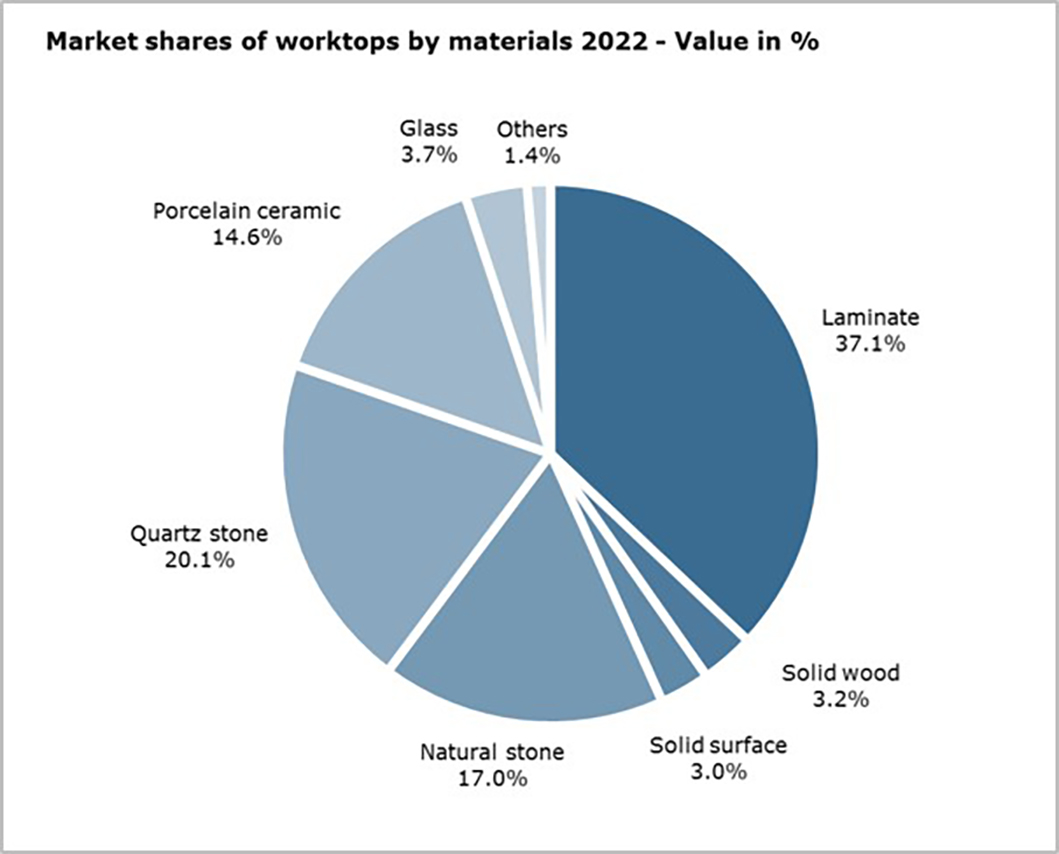Porcelain will play a major part in hard surfaces taking an ever larger slice of the worktop market.
That’s the prediction of a new report on the market from Germany.
Called Worktops in Europe – TOP 10 Countries in comparison from 2017 to 2030, it is available in German and English. The UK is included as one of the top 10 countries.
The report says that with 56.4% of the market, hard surfaces will far exceeded laminate sales by 2030. Laminates are forecast to have 33.2% by then. Porcelain will achieve the highest growth from 2022 to 2030, with sales increasing by 46%.
The report says the general trend has been visible in the Top 10 countries in Europe for years. There have been difficult conditions with the Covid-19 pandemic, the war in Ukraine and inflation throughout Europe, in 2020 to 2022, but despite that, the market for worktops continues to grow.
The market at ex-factory prices has grown by an average of 14% from €1.36billion euros to €1.55billion euros in the past two years, although there are big differences between the 10 analysed countries of Germany, Austria, Switzerland, the Netherlands, Belgium, Great Britain, France, Italy, Spain and Poland.
The report says there are currently 7,261,000 worktops sold in these countries in a year, with prices increasing more strongly than the number of units, both as a result of the move towards hard surfaces and price increases of materials.
Kitchens account for 74.9% of the worktops sold, with 10.6% for bathrooms, 10.0% in the contract business and 4.5% in furniture construction.
The report says laminates are currently particularly prevalent in Great Britain, France and Germany but says this is changing.
Worktops are becoming more individual – and thinner. In all counties combined, the most popular thickness of worktops is 30-40mm, with 20-30mm surfaces having a share of 28%, and those of less than 20 mm with 9.7%. There are striking differences in preferences of thickness in the different countries, with 20-30mm dominating in the UK but porcelains making thinner tops more common.
Product trends are an important part of the development of worktops up to 2030. The interaction of colours of worktops, back panels, kitchen sinks and kitchen taps remains the focus of product development. The colour scheme is thus based on the colours of kitchens and sinks. Accordingly, green, beige and grey tones are gaining market importance.
The report analysis:
- the market size in 2022 and 2030 in euros and units
- the most important material suppliers for worktops
- the biggest fabricators
- which furniture and kitchen retailers determine the business
- the significance of e-commerce today and in 2030
- the contract business
- changes in distribution channels expected by 2030
- current sales of different materials and expected changes by 2030
- product trends
Worktops in Europe contains 552 pages with 296 tables and graphics. It is published this month (July 2023) at a price of €5,000 plus VAT.
It can be ordered from: Unternehmensberatung Titze GmbH, Auf den Stöcken 16, 41472 Neuss. +49 2182 871200. info@titze-online.de / www.titze-online.de

